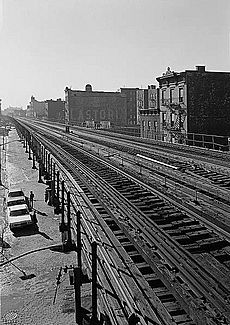IRT Third Avenue Line facts for kids
Quick facts for kids IRT Third Avenue Elevated |
|
|---|---|

Third Avenue elevated trains at 59th Street
|
|
| Overview | |
| Owner | City of New York |
| Termini | Gun Hill Road Bronx Park Terminal City Hall South Ferry |
| Service | |
| Type | Rapid transit |
| System | Interborough Rapid Transit Company |
| Operator(s) | New York City Transit Authority |
| History | |
| Opened | 1878–1891 1901–1920 (North of 177th Street) |
| Closed | 1950–1955 (South of 149th street) 1973 (North of 149th Street) |
| Technical | |
| Number of tracks | 2-3 |
| Character | Elevated |
| Track gauge | 4 ft 8 1⁄2 in (1,435 mm) standard gauge |

The IRT Third Avenue Line, also known as the Third Avenue Elevated or Third Avenue El, was a special train line in Manhattan and the Bronx, New York City. It was an elevated railway, meaning it ran on tracks built high above the streets.
This train line was first run by an independent company. Later, it became part of the Interborough Rapid Transit Company (IRT). Eventually, it joined the larger New York City Subway system.
The first part of the line opened on August 26, 1878. It ran from South Ferry to Grand Central Depot. By December 30, it reached Harlem in Manhattan. In 1881, trains started running 24 hours a day, every day of the week.
The Third Avenue El was the last elevated train line to run in Manhattan. Most of its service in Manhattan stopped in the early 1950s. It closed completely on May 12, 1955. The part of the line that stayed open in the Bronx was called the 8 route. This last section closed on April 29, 1973.
Contents
History of the Third Avenue El
How the Trains Operated

In 1875, a group called the Rapid Transit Commission gave the New York Elevated Railway Company permission to build this train line. It was planned to go from Battery Park to the Harlem River. The tracks would follow the Bowery and Third Avenue.
The Third Avenue El opened in 1878. It ran from South Ferry to 129th Street. In 1879, another company, the Manhattan Railway Company, took over.
Later, in 1886, the Suburban Rapid Transit Company started a line. It crossed the Harlem River on a special double-deck bridge. This bridge had tracks for fast trains and local trains, plus a walkway for people. This line connected to the Manhattan Railway's northern end at 129th Street.
By 1891, the Manhattan Railway took over the Suburban line. This allowed trains to run all the way from the Bronx to Manhattan by 1896. In 1902, the Interborough Rapid Transit Company (IRT) took control of the Manhattan Railway. Around this time, the train line was updated to use electricity.
The line was later expanded to have three tracks. This project allowed for express trains during busy times, making the line carry more people. The middle track in the Bronx opened in 1916. In Manhattan, it opened in 1917.
Why the Third Avenue El Closed
In the 1930s and 1940s, New York City's subway system was changing. The city was combining different train companies. The Third Avenue elevated line, along with others, faced criticism. Many people, including Mayor Fiorello La Guardia, thought these elevated lines were old and made neighborhoods look bad. They believed new underground subways should replace them.
Other elevated lines, like the Second, Sixth, and Ninth Avenue lines, closed between 1938 and 1942. The Third Avenue El stayed open longer. It was supposed to be replaced by a new Second Avenue Subway line. However, people living and working near the Third Avenue El wanted it gone. They formed a group in 1941 to reduce the train noise. They said the noise was bad for health and peaceful home life.
The Third Avenue El closed in different parts over many years.
- On December 22, 1950, the part that went to South Ferry closed.
- On November 14, 1951, the Bronx Park Terminal station closed.
- On December 31, 1953, the part that went to City Hall closed.
- On May 12, 1955, the main part of the line in Manhattan closed. This meant there were no more elevated trains running in Manhattan. This made property values go up in some areas. But it also made it harder for people in parts of the Bronx to get around.
In 1967, the last part of the line in the Bronx was officially called the 8 route. However, the trains usually just showed "SHUTTLE" on their signs.
Plans were made to tear down the rest of the line in the Bronx. People in the Bronx also wanted it gone, hoping their neighborhoods would improve. The last section of the Third Avenue El in the Bronx closed on April 29, 1973. Demolition started in 1977 and was finished by the end of that year.
The new Second Avenue Subway that was supposed to replace it was put on hold. This was because New York City had money problems in the 1970s. In the Bronx, a bus route called the Bx55 replaced the elevated train. This bus route was special because it offered free transfers to and from the subway. Later, this special status was removed when free bus-to-subway transfers became common everywhere. In 2013, the Bx55 bus was replaced by other bus services.
Images for kids
See also
 In Spanish: Línea de la Tercera Avenida (IRT) para niños
In Spanish: Línea de la Tercera Avenida (IRT) para niños






